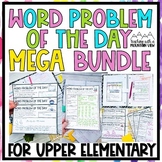Math Word Problem of the Day | 3rd Grade February
- Zip
- Google Apps™

What educators are saying
Also included in
- Solving word problems is a critical component of math instruction and increasing problem-solving skills. This 3rd, 4th, and 5th-grade Word Problem of the Day BUNDLE provides you with 25 unique single and multi-step word problems for every month of the year for each grade level. That's 900-word problPrice $76.99Original Price $114.84Save $37.85
- Solving word problems is a critical component of math instruction and increasing problem-solving skills. This 3rd-grade Word Problem of the Day resource provides you with 25 unique single and multi-step word problems for every month of the year. That's 300 word problems in all! ⭐ This is a COMPLETEPrice $29.99Original Price $38.28Save $8.29
Description
Solving word problems is a critical component of math instruction and increasing problem-solving skills. This 3rd Grade Word Problem of the Day resource provides you with a variety of single and multi-step word problems.
This set of monthly word problems has a February focus with some holiday-themed problems, but they can be used ANY time of year.
⭐ Do you want the whole year? Check out the COMPLETE year of 3rd Grade Word Problem of the Day ⬅️
This set focuses heavily on all four operations, emphasizing fundamental problem-solving skills.
This 3rd Grade Word Problem of the Day February Resource includes:
- 25 Word Problems (Single and Multi-Step)
- Sentence Starter and Math Vocabulary Anchor Chart
- Answer Key
The Daily Word Problem Formats Include:
- Full page with step-by-step instructions for tackling word problems
- Half page with room to show work and write a short explanation
- Five problems on one page for use in an interactive notebook
- Digital version in Google Slides
Please see the preview for a complete overview of the different options available.
Multiple math skills at the 3rd-grade level are covered. Multi-step, single-step, and extra information problems are interspersed so that students must interpret and solve the problem.
When creating this resource, I have placed a heavy emphasis on problem-solving skills and giving students the opportunity to write about math.
Need other grades or want to differentiate with other grade levels?







